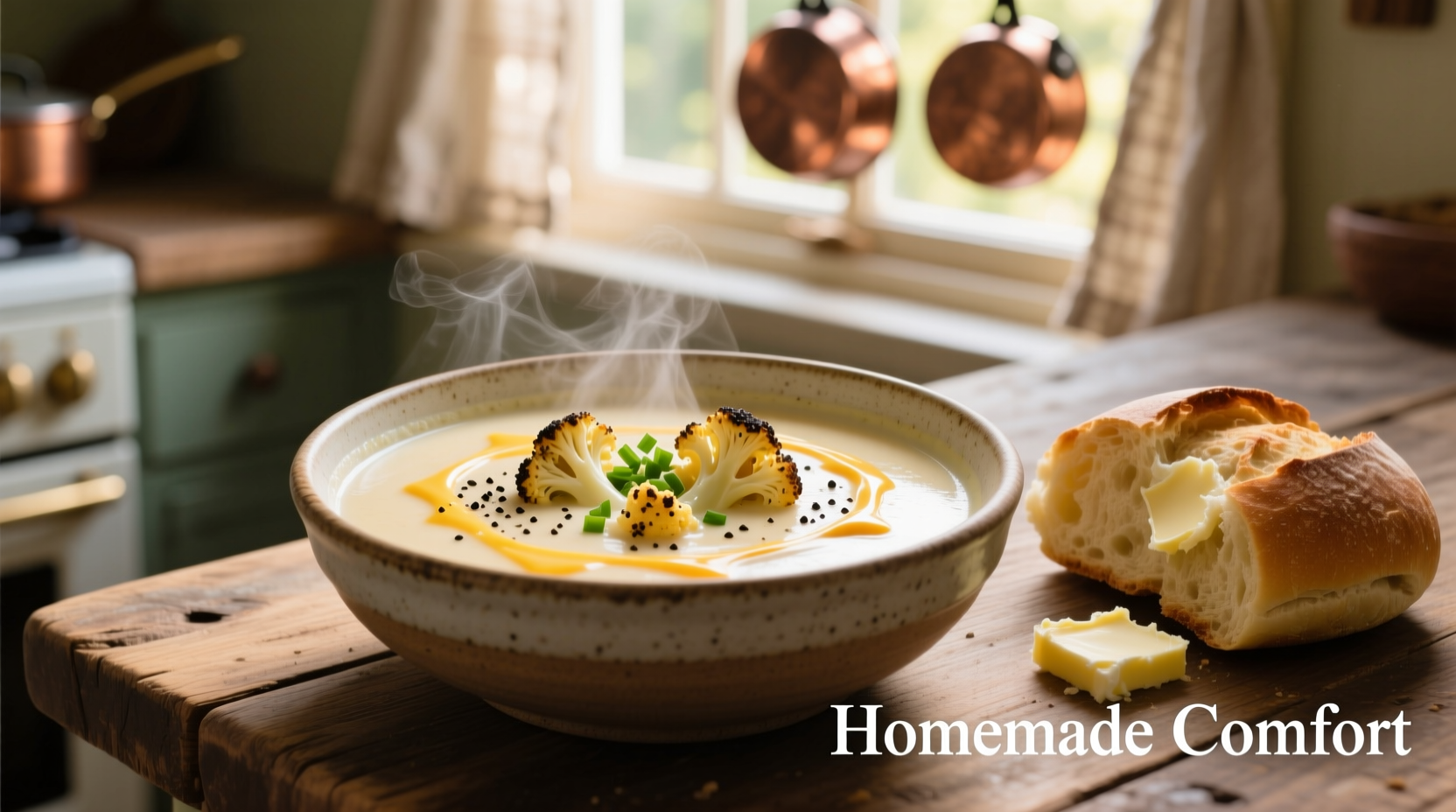Why This Soup Combination Works Perfectly
Understanding the culinary chemistry behind cauliflower and cheddar reveals why they form such a harmonious pairing. Cauliflower's mild, slightly sweet flavor provides the ideal canvas for cheddar's sharp, complex notes. When properly prepared, the soup achieves a velvety texture without heavy cream, making it both elegant and surprisingly healthy.
According to the USDA FoodData Central, cauliflower delivers 77% of your daily vitamin C in just one cup, while cheddar contributes substantial calcium and protein. This nutritional synergy creates a satisfying meal that nourishes both body and soul.

Your Essential Ingredient Guide
Not all ingredients perform equally in this classic soup. Selecting quality components makes the difference between ordinary and extraordinary results.
| Ingredient | Quality Indicator | Why It Matters |
|---|---|---|
| Cauliflower | Firm, compact head with creamy white color | Ensures maximum sweetness and minimal water content |
| Cheddar cheese | Sharp, aged minimum 12 months | Provides complex flavor without becoming grainy when melted |
| Onion | Firm with dry outer skin | Creates proper flavor foundation without bitterness |
| Broth | Low-sodium, preferably homemade | Allows precise seasoning control for balanced flavor |
Step-by-Step Preparation: Professional Technique
Follow this chef-tested method for perfectly textured cauliflower cheddar soup every time. The key lies in proper temperature control during cheese incorporation.
Prep Work (5 minutes)
Break cauliflower into uniform florets (about 1.5 inches). Finely dice onion and celery. Grate cheddar cheese from a cold block - pre-shredded cheese contains anti-caking agents that prevent smooth melting.
Cooking Process (25 minutes)
- Sauté aromatics: Cook onion and celery in butter over medium heat until translucent (5-7 minutes)
- Add cauliflower and broth: Bring to gentle simmer, cover, and cook until fork-tender (12-15 minutes)
- Puree soup: Use immersion blender until completely smooth (critical for velvety texture)
- Incorporate cheese: Reduce heat to low, add cheese gradually while stirring constantly
- Season carefully: Add salt, white pepper, and optional pinch of cayenne
Avoid These Common Mistakes
Even experienced cooks make these critical errors that compromise texture and flavor:
- Adding cheese at high temperature - causes separation and graininess (keep below 160°F/71°C)
- Overcooking cauliflower - creates sulfurous notes that overpower cheese
- Using pre-shredded cheese - contains starches that create clumpy texture
- Skipping the puree step - results in inconsistent texture even with immersion blender
Perfect Variations for Every Dietary Need
This versatile recipe adapts beautifully to various dietary requirements without sacrificing flavor:
Dairy-Free Version
Replace cheddar with 1/2 cup nutritional yeast plus 1 tablespoon white miso paste. The umami compounds create remarkably cheese-like complexity. Add 1/4 cup raw cashews (soaked) for creaminess.
Low-Carb Adaptation
For keto diets, increase cheese content by 25% and use bone broth. Add 1/4 cup heavy cream at the end for additional fat content while maintaining smooth texture.
Kid-Friendly Modification
Reduce cheddar by one-third and add 1/4 cup pureed butternut squash. The natural sweetness masks cauliflower's earthiness while boosting nutritional value.
Storage and Reheating Secrets
Proper storage maintains quality for future enjoyment. According to FDA Food Code guidelines, cooked soup remains safe for 3-4 days refrigerated or 2-3 months frozen.
When reheating, add 1-2 tablespoons milk or broth per cup of soup to restore proper consistency. Never boil reheated cheese soup - maintain temperature below simmering point (180°F/82°C) to prevent separation.
When This Soup Shines: Context Boundaries
Understanding appropriate usage scenarios ensures optimal dining experiences:
- Perfect for: Cold weather meals, vegetarian main courses, elegant dinner parties, healthy comfort food cravings
- Less suitable for: Summer dining, extremely hot climates, formal events requiring clear broths, very spicy food preferences
- Ideal pairings: Crusty artisan bread, simple green salad, roasted chicken, or as a first course before steak
Historical Evolution of Cheddar Cheese
Understanding cheddar's journey enhances appreciation for this soup's flavor foundation:
- 12th century: First production in English village of Cheddar
- 17th century: Development of "cheddaring" technique for texture control
- 19th century: Industrial production begins, spread through British Empire
- 20th century: American adaptation creates milder, orange-hued varieties
- 21st century: Artisanal resurgence emphasizing traditional methods and complex flavors
Modern artisan cheddars used in premium cauliflower soup preparations typically follow traditional English methods, creating the sharp, complex notes essential for exceptional flavor.
Serving Suggestions for Maximum Enjoyment
Elevate your cauliflower cheddar soup experience with these professional presentation techniques:
- Temperature matters: Serve between 160-170°F (71-77°C) for optimal flavor release
- Garnish strategically: Fresh chives, crispy bacon bits, or grated extra-sharp cheddar
- Bread pairing: Warm sourdough or crusty baguette for dipping
- Wine complement: Dry Riesling or unoaked Chardonnay balances richness
Frequently Asked Questions
Can I freeze cauliflower cheddar soup successfully?
Yes, but with important technique. Cool soup completely before freezing. When reheating, add 1-2 tablespoons liquid per cup as cheese-based soups can separate. Avoid boiling - maintain gentle warmth below 180°F (82°C) for best results. Properly frozen soup maintains quality for 2-3 months.
Why does my cauliflower soup become grainy when adding cheese?
Graininess occurs when cheese is added to liquid above 160°F (71°C). Always reduce heat to low before incorporating cheese. Use freshly grated cheese from a cold block - pre-shredded varieties contain anti-caking agents that prevent smooth melting. Add cheese gradually while stirring constantly for optimal texture.
How can I make my cauliflower soup thicker without adding flour?
Several effective flour-free thickening methods exist: Simmer uncovered for 5-10 minutes to reduce liquid, add 1/4 cup cooked potatoes during pureeing, or incorporate 2-3 tablespoons raw cashews (soaked) for creamy texture. Roasting cauliflower before cooking also concentrates flavors and creates natural thickness.
What's the best cheddar variety for cauliflower soup?
Sharp cheddar aged minimum 12 months provides optimal flavor complexity without becoming overly salty. English farmhouse cheddars offer particularly nuanced profiles. Avoid mild cheddars as they lack sufficient flavor impact. For balanced results, combine 3/4 sharp cheddar with 1/4 medium cheddar for ideal meltability and taste.











 浙公网安备
33010002000092号
浙公网安备
33010002000092号 浙B2-20120091-4
浙B2-20120091-4